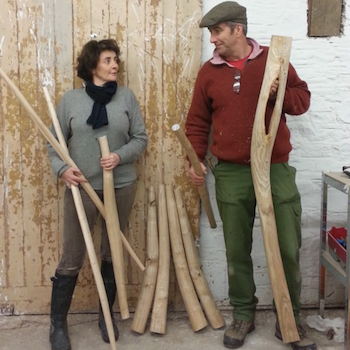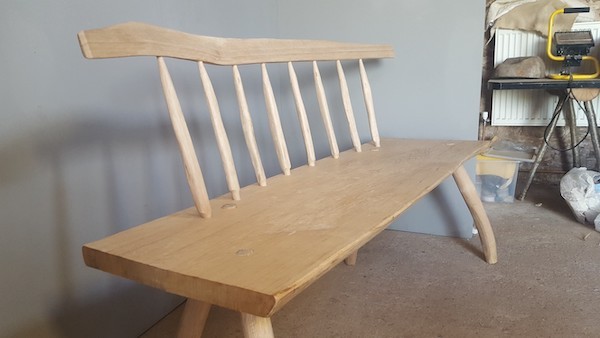
Peter Lanyon is an award-winning furniture maker renowned for combining coppiced, unseasoned wood with other materials. He champions the use of sustainable, home-grown British hardwoods and his creations are breath-takingly beautiful. You would be forgiven for thinking that he would want to keep these specialist skills top secret but in fact he runs courses from his tranquil workshop in South Devon, and internationally, and exhibits at the best craft fairs in the country.
We asked Peter how he got into green wood-working, what it is and why he loves to pass on this traditional craft…


Green woodworking is the method of taking a freshly cut tree, and splitting it along its grain to make furniture and other products.
Typically a log of between 10cm - 25cm is used, usually from timbers such as ash, sweet chestnut, cherry, beech and oak. These trees can be “coppiced” - cut close to the ground in a sustainable way, allowing the stump to send out shoots and quickly regenerate.
Large diameter logs can also be split with enough helpers, some hefty mallets (or “beetles”) and a good quantity of oak wedges (or gluts).
I found my way to green woodworking after training in fine furniture – I'd always seen it as something a bit rustic and unrefined, and maybe less skilled. It isn't.
There are any number of reasons for making furniture the way I do, but the principal reasons for me are the unique aesthetics of green wood furniture, and the environmental benefits.
There is something natural and honest about a piece of wood that has been cleaved from a round pole, and shaved by hand with sharp tools. The nuances of each piece - the undulations of grain, medullary rays on the radial faces, the dips and mounds as the grain encloses knots, or the beautiful ripples that develop under the tensile and compressive forces that build up on curves.
With practice and a little luck these can be read in the log before it is split.



The main advantage of green wood is that it can be split. When green wood is wet the lignin* in it is soft, and allows the wood to split easily.
Dry wood is brittle when wet, and splitting it often results in cracking, rather than a controlled split. This means you can retain the natural shape of the tree. The saw is no respecter of grain, and just slices across it where it is told to.
Cleaved wood is stronger than sawn wood, as there is always a continuous line of grain running through the piece. This means components can be made smaller in diameter, and consequently lighter.
Working wood green is a healthy, physically rewarding activity that can be carried out in the woods, workshop, or front room!
There is no dust generated from cleaving and shaving, and the shavings can be put to use lighting fires, or providing mulch for the garden. I am experimenting with using mine as an environmental packaging material. Using young coppiced trees is a sustainable way of using wood. The roots stay in the ground, and the trees quickly regenerate.

I run a range of courses and workshops both in my Devonshire workshop and in Portugal, and they are nearly all suitable for beginners.
Many of those who have been on my courses get bitten by the green wood bug, and are soon ordering tools and timber! It is a fabulous, healthy, practical, useful and rewarding hobby.
Check out my green wood furniture courses if you fancy some hands-on learning about green woodworking, and taking away a unique, gorgeous hand-made family heirloom.


If you like the sound of green woodworking and would like to find a course close to you have a browse here >
*Lignin is a class of complex organic polymers that form key structural materials in the support tissues of vascular plants and some algae. Lignins are particularly important in the formation of cell walls, especially in wood and bark, because they lend rigidity and do not rot easily.



